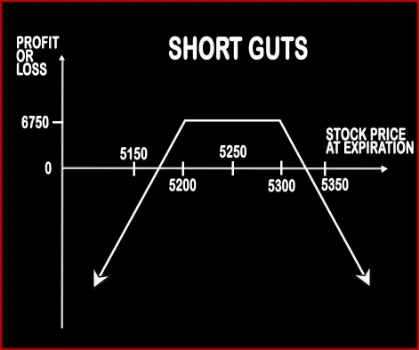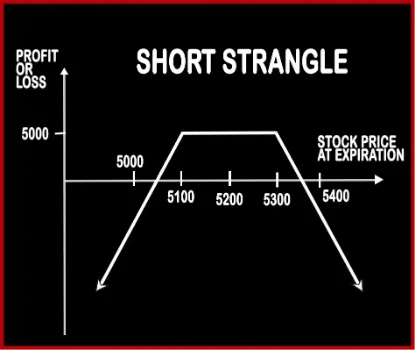Compare Strategies
| SHORT GUTS | SHORT STRANGLE | |
|---|---|---|

|

|
|
| About Strategy |
Short Guts Option StrategyThis strategy is implemented by a trader when he is neutral on the movements and bearish on volatility i.e. he expects the stock to be range bound in the near future. This strategy involves sale of 1 ITM Call Option and 1 ITM Put Option. This strategy can be called as Credit Spread since his account is credited at the time of entering in the positions. |
Short Strangle Option StrategyThis strategy is similar to Short Straddle; the only difference is of the strike prices at which the positions are built. Short Strangle involves selling of one OTM Call Option and selling of one OTM Put Option, of the same expiry date and same underlying asset. Here the probability of making profits is more as there is a spread between the two strike prices, and if .. |
SHORT GUTS Vs SHORT STRANGLE - Details
| SHORT GUTS | SHORT STRANGLE | |
|---|---|---|
| Market View | Neutral | Neutral |
| Type (CE/PE) | CE (Call Option) + PE (Put Option) | CE (Call Option) + PE (Put Option) |
| Number Of Positions | 2 | 2 |
| Strategy Level | Beginners | Advance |
| Reward Profile | Limited | Limited |
| Risk Profile | Unlimited | Unlimited |
| Breakeven Point | Upper Breakeven Point = Net Premium Received + Strike Price of Short Call, Lower Breakeven Point = Strike Price of Short Put - Net Premium Received | Lower Break-even = Strike Price of Put - Net Premium, Upper Break-even = Strike Price of Call+ Net Premium |
SHORT GUTS Vs SHORT STRANGLE - When & How to use ?
| SHORT GUTS | SHORT STRANGLE | |
|---|---|---|
| Market View | Neutral | Neutral |
| When to use? | This strategy is implemented by a trader when he is neutral on the movements and bearish on volatility i.e. he expects the stock to be range bound in the near future. | This strategy is perfect in a neutral market scenario when the underlying is expected to be less volatile. |
| Action | Sell 1 ITM Call, Sell 1 ITM Put | Sell OTM Call, Sell OTM Put |
| Breakeven Point | Upper Breakeven Point = Net Premium Received + Strike Price of Short Call, Lower Breakeven Point = Strike Price of Short Put - Net Premium Received | Lower Break-even = Strike Price of Put - Net Premium, Upper Break-even = Strike Price of Call+ Net Premium |
SHORT GUTS Vs SHORT STRANGLE - Risk & Reward
| SHORT GUTS | SHORT STRANGLE | |
|---|---|---|
| Maximum Profit Scenario | Net Premium Received + Strike Price of Short Put - Strike Price of Short Call - Commissions Paid | Maximum Profit = Net Premium Received |
| Maximum Loss Scenario | Price of Underlying - Strike Price of Short Call - Net Premium Received OR Strike Price of Short Put - Price of Underlying - Net Premium Received + Commissions Paid | Loss = Price of Underlying - Strike Price of Short Call - Net Premium Received |
| Risk | Unlimited | Unlimited |
| Reward | Limited | Limited |
SHORT GUTS Vs SHORT STRANGLE - Strategy Pros & Cons
| SHORT GUTS | SHORT STRANGLE | |
|---|---|---|
| Similar Strategies | Short Strangle (Sell Strangle), Short Straddle (Sell Straddle) | Short Straddle, Long Strangle |
| Disadvantage | • Unlimited potential loss if the underlying stock continues to move in one direction. • High margin required. | • Unlimited loss is associated with this strategy, not recommended for beginners. • Limited reward amount. |
| Advantages | • Ability to profit even when underlying asset stays stagnant. • You are already paid your full profit the moment the position is put on as this is a credit spread position. • Higher chance of ending in full profit as compared to short strangle or short straddle. | • Higher chance of profitability due to selling of OTM options. • Advantage from double time decay and a contraction in volatility. • Traders can book profit when underlying asset stays within a tight trading range. |